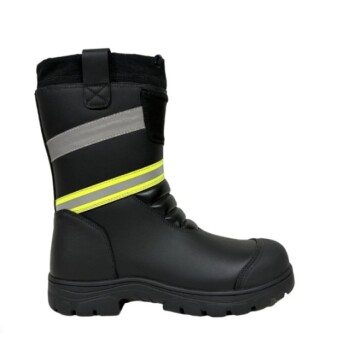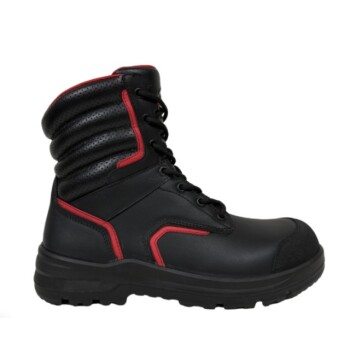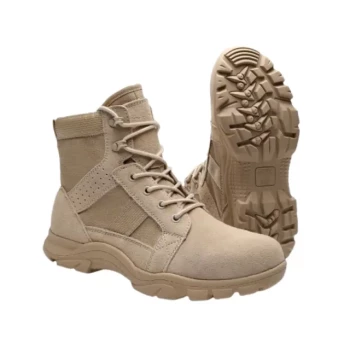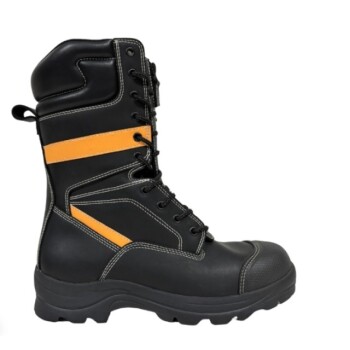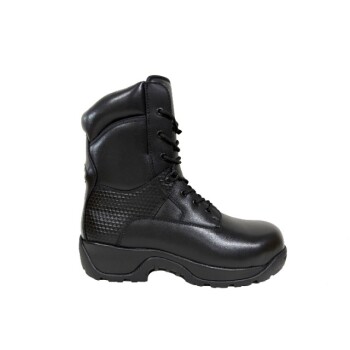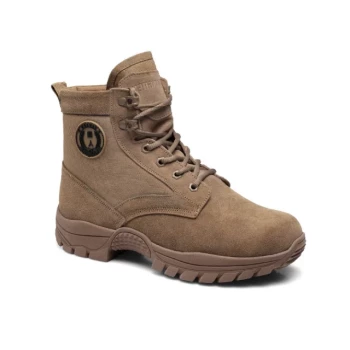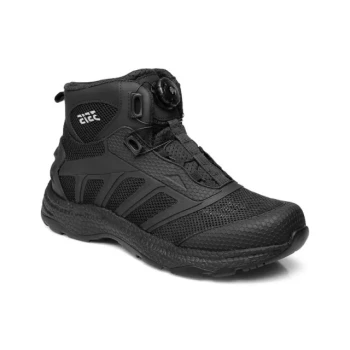The best hiking shoe is not a single type of shoe. The ideal choice depends entirely on the terrain you'll be on, the weather you expect, and the weight of the pack you'll be carrying. Your options range from lightweight trail runners for speed on gentle paths to rugged, high-cut boots for stability on demanding mountain itineraries.
The central challenge is not finding the one "best" shoe, but matching the footwear's characteristics—support, weight, and weather resistance—to the specific demands of your hike. Prioritizing the right tool for the job is the most effective way to prevent discomfort, blisters, and potential injury.

Matching Footwear to Your Hike
Before looking at specific shoe types, you must first analyze the context of your activity. The environment dictates the gear.
The Terrain Dictates Support
Different ground surfaces place different demands on your feet and ankles. A simple walk on a well-groomed path requires far less support than a scramble over rocky, uneven terrain.
More demanding trails with loose rock or steep inclines require a shoe with a stiffer sole and more ankle support to prevent twists and provide a stable platform.
The Weather Dictates Materials
Your footwear's materials directly impact your comfort in different climates. A heavy, insulated boot will be miserable in a hot, dry desert, just as a highly breathable mesh shoe is a poor choice for a snowy trail.
For warm climates, prioritize breathability to manage sweat and keep your feet cool. For cold or consistently wet conditions, waterproofing and insulation become critical.
The Pack Weight Dictates Structure
The weight on your back significantly impacts the force on your feet and ankles. Carrying a simple daypack is very different from hauling a 40-pound pack for a multi-day trip.
A heavier load requires a more robust boot, typically with a mid or high-cut design, to provide the necessary ankle support and prevent fatigue and injury over long distances.
A Breakdown of Your Primary Options
With a clear understanding of your needs, you can now evaluate the most common types of hiking footwear.
Trail Runners: For Speed and Agility
Trail runners are essentially running shoes with a more aggressive, rugged grip. They are the lightest and most flexible option.
They are an excellent choice for day hikes, fast-packing with a light load, and use on well-maintained trails. Their primary drawback is a shorter lifespan, often needing replacement after around 500 miles.
Hiking Shoes: The Versatile All-Rounder
These are the middle ground between trail runners and full boots. They are more durable and supportive than a trail runner but lighter and more flexible than a traditional boot.
Hiking shoes, often in a low or mid-cut design, are perfect for most day hikes and even some shorter backpacking trips on moderate terrain.
Hiking Boots: For Maximum Support and Protection
Hiking boots are the heaviest and most robust option, built for durability and stability. Their stiff soles protect your feet from sharp rocks, and their high-cut design provides maximum ankle support.
Choose a hiking boot for navigating rugged, off-trail terrain, carrying a heavy backpack for multiple days, or hiking in demanding winter conditions.
Alternative Options: Tactical Boots and Sandals
Some tactical boots can serve as effective hiking footwear, as they are often built with durability, traction, and ankle support in mind.
Sports sandals are a niche option. They are only viable for very easy, well-groomed trails with a light pack, and only for hikers with strong, confident ankles. They offer minimal protection and are unsuitable for rugged terrain.
Understanding the Trade-offs: The Waterproofing Dilemma
One of the most common points of confusion is whether to choose waterproof footwear. The answer involves a significant trade-off.
The Case for Waterproofing
Footwear with a waterproof membrane (like Gore-Tex) is designed to keep your feet dry from external moisture like rain, puddles, and snow.
This is a clear advantage in cold, consistently wet environments where keeping your feet dry is essential for preventing blisters and maintaining warmth.
The Case for Breathability
The primary downside of a waterproof membrane is that it traps moisture. Your feet sweat, and this moisture can get trapped inside the shoe, making your socks damp from the inside.
Furthermore, if a waterproof boot is fully submerged in a river crossing, the water that gets in cannot easily get out. The boot becomes waterlogged and can take a very long time to dry, which is a primary cause of blisters. In contrast, a non-waterproof, breathable shoe will dry out much more quickly.
Making the Right Choice for Your Goal
Always pair your footwear with a quality pair of seamless wool or synthetic socks. The sock's cushioning and moisture-wicking properties are just as important as the shoe itself.
- If your primary focus is day hiking on well-maintained trails: A lightweight trail runner or low-cut hiking shoe offers the best balance of comfort and grip.
- If your primary focus is multi-day backpacking with a heavy pack: A mid or high-cut hiking boot is essential for providing the ankle support and structural integrity you need.
- If your primary focus is hiking in consistently wet or cold conditions: A waterproof boot will provide the most reliable protection from the elements.
- If your primary focus is hiking in hot weather with potential river crossings: A breathable, non-waterproof trail runner or hiking shoe will dry faster and keep your feet cooler and more comfortable.
Ultimately, the right footwear is the one that lets you focus on the journey, not on your feet.
Summary Table:
| Footwear Type | Best For | Key Features |
|---|---|---|
| Trail Runners | Day hikes, light packs, well-maintained trails | Lightweight, flexible, fast-drying |
| Hiking Shoes | Versatile day hiking, moderate terrain | Durable, supportive, low/mid-cut design |
| Hiking Boots | Rugged terrain, heavy packs, multi-day trips | Maximum ankle support, stiff sole, durable |
Ready to equip your next adventure with the perfect footwear?
As a large-scale manufacturer, 3515 produces a comprehensive range of hiking shoes and boots for distributors, brand owners, and bulk clients. Whether you need lightweight trail runners for speed or rugged, high-cut boots for demanding terrain, our production capabilities ensure quality, durability, and performance for every trail condition.
Contact us today to discuss your footwear needs and discover how we can support your business with reliable, high-performance hiking gear.
Visual Guide

Related Products
- Wholesale High-Traction Camo Boots - Custom Manufacturer for Brands
- Factory-Direct Wholesale Canvas Boots with High-Traction Rubber Soles
- Safety Footwear Wholesale Manufacturer for Custom OEM/ODM Production
- Factory Direct Wholesale Rain Boots Durable Waterproof & Fully Customizable
- High Performance Fire-Retardant Waterproof Safety Boots
People Also Ask
- Are military camouflage boots waterproof? How to Choose Boots That Keep Feet Dry
- What benefits do the men's camo boots provide? Superior Protection & Comfort for Demanding Terrain
- Why might wearing multiple pairs of socks be counterproductive? Avoid This Common Cold-Weather Mistake
- What are the key features of the new line of camo boots? Built for Extreme Cold & Rugged Terrain
- What technologies are used in the men's 8-inch camo lace-up boots? A Guide to Rugged Outdoor Performance




